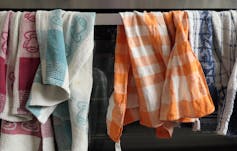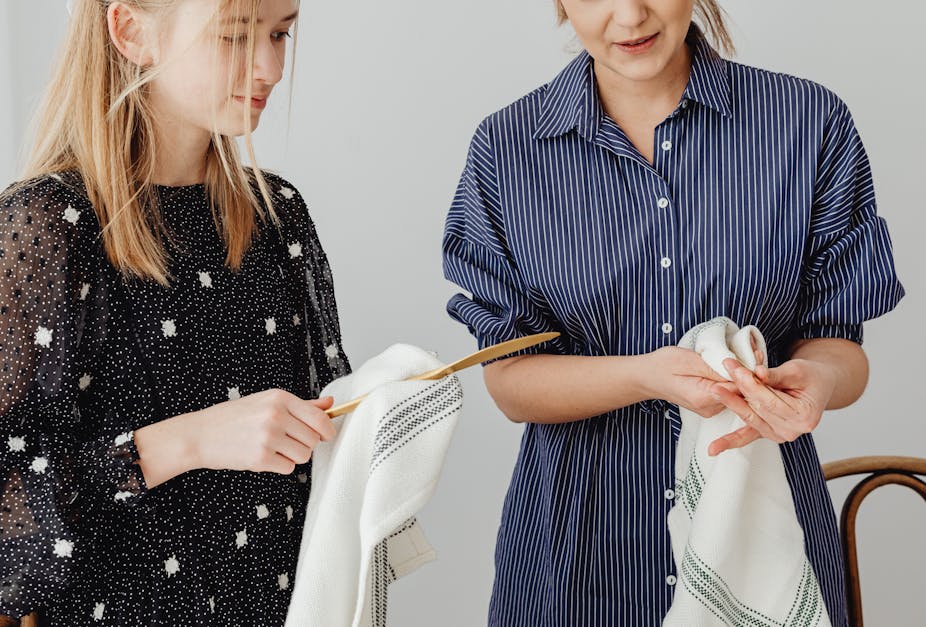Kitchens can harbour all sorts of germs and bacteria. These can arrive via humans, pets, uncooked food or even plants, meaning that a high proportion of foodborne infections are acquired directly within the home.
An important cleaning aid in most kitchens is the tea towel, also known as a dishcloth. Usually made of cotton or linen, they are used to dry wet hands and kitchen implements as well as wiping down surfaces – so play an important role in kitchen hygiene.
But, because hands and uncooked fresh produce are often rich in a diverse variety of germs, tea towels are prone to picking up the bacteria they come into contact with.
Indeed, in a study that used tea towels to wipe down chopping boards that had been used to prepare raw chicken with salmonella (which can cause diarrhoea, fever and stomach cramps), 90% of the cloths became contaminated with salmonella, too.
Several studies have looked at the germs tea towels typically carry in domestic kitchens. One study sampled 100 used tea towels and found a marked presence of staphylococcus aureus Staphylococcus aureus, which is often found on the skin but is also a pathogen that can cause a variety of issues such as abscesses, joint infections and even pneumonia.

Tea towels are good at picking up germs which is important as another study of 46 kitchens found a wide range of harmful bacterial species living on kitchen surfaces, which are often cleaned by tea towels.
Surfaces were found to have Enterobacter (which can cause respiratory tract infections, skin infections, urinary tract infections and heart, bone and eye infections), Klebsiella (which has been linked to serious infections of the lungs, bladder, brain and blood), and E. coli (which can cause upset stomachs and urinary tract infections).
Several kitchens also had Pseudomonas aeruginosa, which can cause lung infections. Bacillus subtilis, which can lead to eye infections and abscesses, was also found in more than half of the kitchens sampled. And all of the samples from the kitchens were found to have Staphylococcus and Micrococcus. In people with weak immune systems, Micrococcus has been linked to lung infections, such as pneumonia and septic arthritis along with eye and heart infections.
The levels and types of germs found on these tea towels were influenced by how they were used, how often they were washed and how long they were dried for. Rinsing tea towels in hot water at 60°C was found to reduce levels of bacteria later spread by contaminated cloths, which is important as infection likelihood is often related to how many bacteria you ingest.
Clean your cloths
These studies suggest there is an infection risk from tea towels and that most kitchen cloths may be contaminated with high levels of bacteria. It’s easy, then, for these germs to transfer on to food preparation surfaces, potentially causing serious food poisoning.
The infection risk of using tea towels is well-recognised by the medical profession. Indeed, in UK hospitals, fabric tea towels are not allowed. Instead, patient crockery, cutlery and food preparation work surfaces are cleaned and dried with disposable paper towels.
One of the reasons tea towels act as such good microbial reservoirs is that they are often damp as they are used to absorb moisture and mop up spills. Water enables germs to grow. And so a moist tea towel left in a warm kitchen provides an ideal environment for bacteria to multiply. This is particularly the case if food traces are present, too.
So what’s the best way to sanitise your used tea towel? Tea towels that are hung up in the air tend to dry faster than cloths stored and squeezed into balls, which can affect levels of bacteria in the towels.
Laboratory experiments that involved covering tea towels in salmonella, found that the bacteria multiplied in all types of cloths that were crumpled. But levels of bacteria were reduced by 1,000 times if the tea towels were hung to dry for 24 hours at room temperature.
Reduce the germs
To avoid tea towels spreading germs around the kitchen, it’s recommended that the cloths are washed regularly and when they get wet, are allowed to dry completely before being used again. Using disposable cloths or paper towels for heavily contaminated areas, such as those involving raw meat, could also help to stop the spread of bacteria.
In terms of tea towel hygiene, you should clean and thoroughly dry your kitchen towel at least once a day or after each use. The UK government recommends that tea towels should be sanitised by washing them in a washing machine with laundry detergent on a hot wash cycle of 90°C.

Laundry detergents contain hard water softeners, surfactants (which increase the wetting effect of water by reducing its surface tension), detergents, bleaches and digestive enzymes. Food stains on tea towels will probably be a mixture of proteins, fats and carbohydrates, which the enzymes degrade.
And the detergent helps to dissolve the stains, which are released into the washing water. Since proteins and fats are also involved in the attachment of bacteria to surfaces, laundry detergents will help to detach and so reduce bacteria levels in tea towels.
If you wash tea towels by hand, ensure any obvious food and dirt are removed by rinsing in hot water with detergent before disinfection. After washing, you can sanitise any microbes remaining using boiling water or a disinfectant such as bleach, diluted as per the manufacturer’s instructions.
Ironing tea towels on a hot setting will also effectively sanitise as the temperature is above 90°C. You should also store your laundered tea towels in a dry, clean area, away from any uncooked food and grubby hands.

